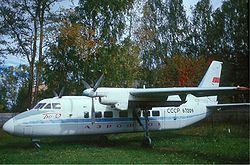Beriev Be-30
| Beriev Be-30 | |
|---|---|
 Beriev Be-32 of Aeroflot |
|
| Type: | Short-haul aircraft |
| Design country: | |
| Manufacturer: | |
| First flight: |
March 3, 1967 |
The Beriev Be-30 ( Russian Бериев Бе-30 ) is an aircraft produced by the Soviet manufacturer Beriev . It is a cantilevered shoulder wing . The first flight with two 740-horsepower ASch-21 - radial engines took place on March 3, 1967th The first flight with turbines was completed on July 13, 1968.
development
The reason for the development of a land plane by OKB Beriev, which actually specializes in flying boats , was Nikita Khrushchev's decision in the 1960s to stop developing flying boats. The development goal was to create a type of aircraft that would replace the Antonov An-2 , Lissunow Li-2 and Ilyushin Il-14 models . Work began in 1965 under G. M. Belkow and after the first flight on March 3, 1967, the prototype was presented to the public on July 8 of the same year in Domodedovo . The machine was also presented at the Paris Air Show Salon International de l'Aeronautique et de l'Espace in 1969 in the West.
The machine, made entirely of metal, was powered by two turboprop engines, which were attached to the leading edge of the wing. The wing was provided with a slightly negative V-shape on the outer wing pieces. The spar was milled. Chemical processes were also used. The removable wing nose was made of a glued construction. About half of the wing was made of a sandwich honeycomb core construction . Double- gap landing flaps were used to improve slow flight characteristics. The machine has STOL properties. The nose wheel landing gear was retractable. The wing, tail unit and the air intakes were heated by bleed air to prevent ice from forming. The windshield and three-bladed propellers, 3 m in diameter, had an electrical heating system. There have been attempts to couple the two engines with one another by means of a shaft in order to achieve better handling of the machine in the event of an engine failure during the critical take-off and landing phase. The system was tested, but not used in series. The power supply was provided by two three-phase generators with a total output of 32 kW in a 200 V on-board network. The cabin, which had its own passenger stairs, was air-conditioned. Up to 20 passengers could be transported in high-density seating and without the luggage compartment.
The avionics were sufficient to be able to fly in all weather conditions. Autopilot and ILS were standard. The Be-30 also had a system that automatically compensates for crosswinds during takeoff and landing.
The Be-30 was in direct competition with the Antonow An-28 . In a comparison flight for Aeroflot, both types performed well, but there were no significant orders. Aeroflot chose the Let L-410 . So only three series machines were produced. Numerous experiments were carried out with them between 1967 and 1976. The machine was redesigned in details and was given the designation Beriev Be-32 .
Technical specifications
| Parameter | Data |
|---|---|
| crew | 1-2 |
| Passengers | 14-15 |
| length | 15.70 m |
| span | 17.00 m |
| height | 5.52 m |
| Wing area | 32.0 m² |
| Cabin size (W × H × D) | 1.50 x 1.82 x 5.66 m |
| wheelbase | 4.75 m |
| Gauge | 5.20 m |
| payload | 1300 kg |
| Takeoff mass | maximum 5860 kg |
| drive | 2 × Gluschenko TWD-10 |
| Starting power | 699 kW (950 PS) each |
| Top speed | 480 km / h at an altitude of 2000 m |
| Cruising speed | 460 km / h |
| Take-off speed | 135 km / h |
| Landing speed | 130 km / h |
| Range with maximum payload | 400 km |
| Range with maximum fuel | 1300 km |
| Take-off / landing runway | 170 m / 130 m |
| Take-off distance over 15 m | 250 m |
Notes and individual references
- ↑ a b c according to Aerosport No. 8/1967 the first flight took place on March 9, 1967 (p. 298)
- ^ Karl-Heinz Eyermann , Wolfgang Sellenthin: The air parades of the USSR. Central Board of the Society for German-Soviet Friendship, 1967. p. 40
- ↑ NZZ : The XXVIII e Salon International de l'Aeronautique et de l'Espace in Paris , July 9, 1969, noon edition page 9
- ^ Heinz AF Schmidt: Flieger-Jahrbuch 1969 . Transpress, Berlin 1968, p. 89 .